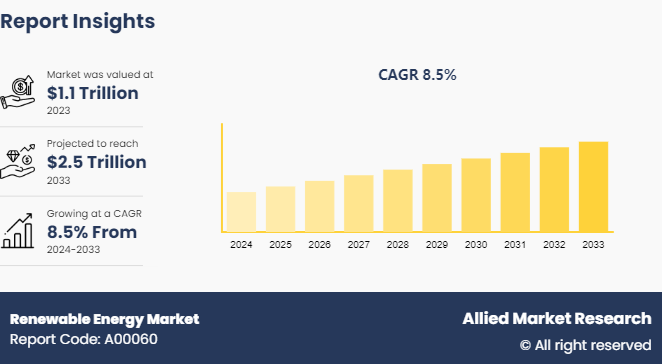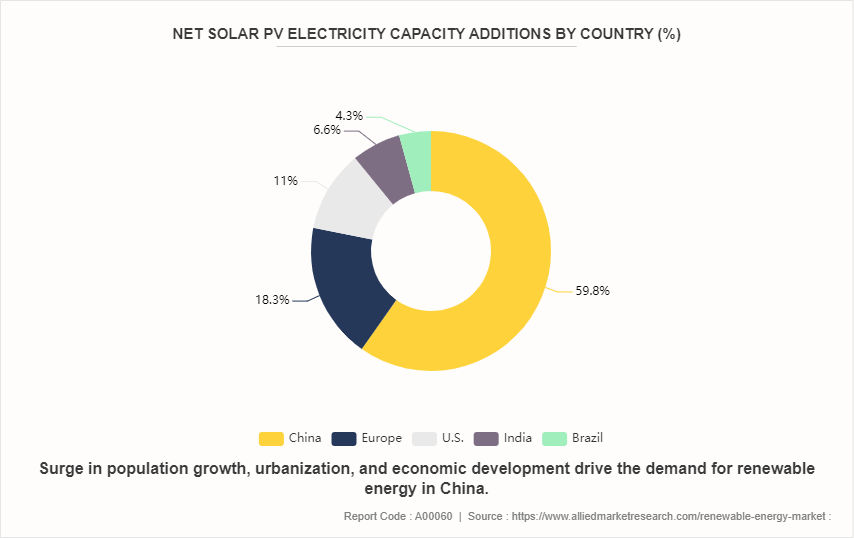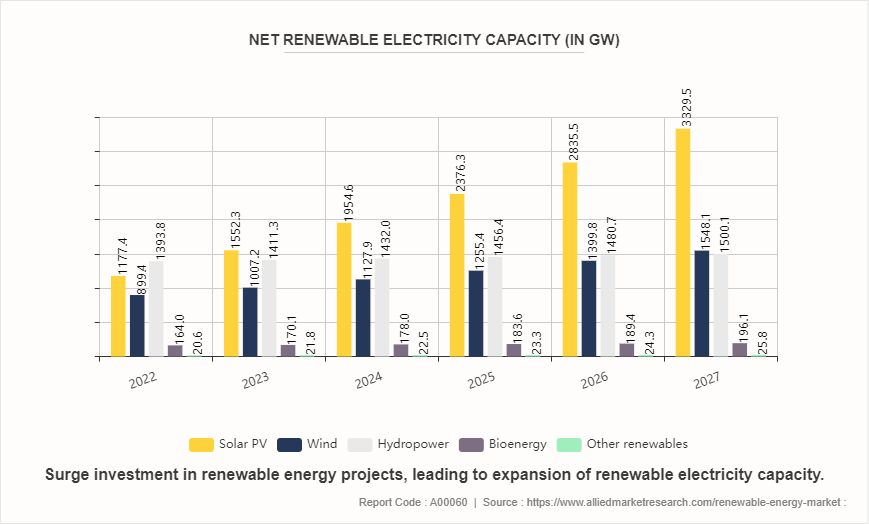Renewable Energy Market Research, 2033
The global renewable energy market size was valued at $1.1 trillion in 2023, and is projected to reach $2.5 trillion by 2033, growing at a CAGR of 8.5% from 2024 to 2033.
Market Introduction and Definition
Renewable energy refers to energy that is generated from naturally replenishing sources referred to as infinite resources. These sources include sunlight, wind, rain, tides, waves, and geothermal heat. Renewable energy sources are sustainable and have minimal impact on the environment as compared to fossil fuels such as coal, oil, and natural gas, which are finite and contribute to environmental degradation through greenhouse gas emissions and pollution.
The adoption of renewable energy has gained momentum globally due to increase in concerns about climate change, energy security, and the depletion of fossil fuel reserves. Governments, businesses, and individuals are investing in renewable energy technologies to reduce greenhouse gas emissions, diversify energy sources, and promote sustainable development. In addition, advancements in technology and declining costs have made renewable energy increasingly competitive with conventional energy sources, driving its rapid deployment and integration into the energy mix. Renewable energy plays a crucial role in mitigating climate change and ensuring a reliable and resilient energy supply as the world transitions towards a cleaner and more sustainable energy future.

Key Takeaways
The renewable energy market report covers 20 countries. The research includes a segment analysis of each country in terms of value for the projected period.
More than 1,500 product literatures, industry releases, annual reports, and other such documents of major renewable energy industry participants along with authentic industry journals, trade associations' releases, and government websites have been reviewed for generating high-value industry insights.
- The study integrated high-quality data, professional opinions and analysis, and critical independent perspectives. The research approach is intended to provide a balanced view of global markets and to assist stakeholders in making educated decisions to achieve their most ambitious growth objectives.
Key Market Dynamics
The growing emphasis on environmental, social, and governance (ESG) criteria among investors has led to a significant shift towards sustainable investments. Companies and financial institutions are increasingly prioritizing renewable energy projects to align with their ESG goals, attracting a broader base of socially conscious investors. This trend boosts the demand for clean energy market and fosters innovation and competitiveness within the sector. As more capital is directed towards clean energy industry, economies of scale are achieved, leading to cost reductions and technological advancements, which further stimulate market demand and accelerate the transition to a low-carbon economy. In addition, government policies and incentives play a crucial role in driving the demand for renewable energy. All these factors are expected to drive the growth of the renewable energy market during the forecast period.
However, high capital costs hinder the adoption of renewable energy by residential and small business consumers. Although the long-term savings from reduced energy bills and potential earnings from selling excess power back to the grid are substantial, the initial cost of purchasing and installing renewable energy systems are prohibitive. In addition, the cost of installing renewable energy infrastructure often includes the expenses for advanced technology, specialized equipment, and extensive site preparation. For instance, the initial costs for solar panel installations involve the panels themselves and the inverters, mounting systems, and labor. All these factors hamper the renewable energy market growth.
The integration of renewable energy into smart grids enhances energy efficiency and reduces system losses. Smart meters, sensors, and automation technologies allow for more precise monitoring and control of electricity consumption, enabling utilities to identify inefficiencies and implement demand-side management strategies. In addition, distributed renewable energy generation at the local level, such as rooftop solar panels or community wind turbines, reduces the need for long-distance transmission of electricity, minimizing energy losses during transmission and distribution. Furthermore, smart grids facilitate the integration of electric vehicles (EVs) and other forms of distributed energy resources (DERs) . As the adoption of EVs continues to rise, smart grids support vehicle-to-grid (V2G) technology, enabling EV batteries to store and discharge electricity back to the grid as needed. All these factors are anticipated to offer new growth opportunities for the global renewable energy market during the forecast period.
Market Segmentation
The renewable energy market is segmented into type, end use, and region. By type, the market is classified into hydroelectric power, wind power, bioenergy, solar energy, and geothermal energy. By end use, the market is divided into residential, commercial, industrial, and utilities. Region-wise the market is analyzed across North America, Europe, Asia-Pacific, and LAMEA.
Regional Market Outlook
The Asia-Pacific region's increasing energy demand, driven by population growth, urbanization, and economic development drive the demand for renewable energy. As countries in Asia-Pacific seek to meet their growing energy needs while reducing their reliance on fossil fuels, renewable energy offers a sustainable and domestically available alternative. In addition, policy support and government initiatives play a crucial role in accelerating the adoption of renewable energy across the region. Countries have implemented ambitious renewable energy targets, feed-in tariffs, tax incentives, and other supportive policies to incentivize investment in clean energy technologies. For instance, countries such as China, India, Japan, and Australia have committed to significant renewable energy capacity additions and carbon reduction goals, driving substantial investment in wind, solar, hydroelectric, and other renewable energy projects.

- According to the Invest India, India stands 4th globally in renewable energy installed capacity (including Large Hydro) , 4th in wind power capacity, and 5th in solar power capacity. The country set an enhanced target at COP26 of 500 GW of non-fossil fuel-based energy by 2030. As of 2024, renewable energy sources including large hydropower, have a combined installed capacity of 191.67 GW.
- According to the Internation Energy Agency (IEA) , in 2022 China accounted for almost half of all new renewable power capacity worldwide. By 2024, the country’s share is set to have expanded to a record 55% of global annual renewable capacity deployment.
- India has committed to reduce emissions intensity of India’s gross domestic product (GDP) below 45% by 2030. Strong commitments have led to an ever-expanding renewable energy sector, which addresses energy security and environmental concerns and facilitates a more sustainable and equitable future for its citizens.
Competitive Landscape
The major players operating in the renewable energy market outlook include Xcel Energy Inc., General Electric, ACCIONA, Tata Power, National Grid Renewables, Invenergy, ABB, Enel Green Power S.p.A., EDF Renewables, and Innergex.
- In February 2024, Grew Energy launched cutting edge solar PV modules at Intersolar. The company launched its technologically advanced ‘P-type’ and ‘N-type’ solar PV modules during the event, marking a significant milestone in the advancement of sustainable energy solutions.
- In December 2023, Ricoh launched its first renewable energy self-consignment. This initiative is a part of Ricoh's efforts to achieve its 2030 target of 50% renewable energy in the overall electricity used for the business.
- In February 2023, Green World Renewable Energy LLC launched innovative solar panel and combiner box at ISNA, solar storage exhibition. This solar energy product provides a reliable and efficient solution for harnessing the power of the sun. This system is designed to meet the growing demand for renewable energy sources and provides a clean, cost-effective, and sustainable alternative to traditional energy sources.
Surge in Net Renewable Electricity Capacity
The continuous growth in net green energy industry reflects a growing confidence among investors, governments, and energy stakeholders in the viability and potential of renewable energy sources. This drive investment in green energy market, leading to expansion of capacity and market development. In addition, the growing net renewable electricity capacity drives innovation and technological advancements in renewable energy technologies. As demand for renewable energy grows, there is greater incentive for research and development, leading to improved efficiency, cost-effectiveness, and scalability of renewable energy systems. This, in turn, enhances the competitiveness of renewable energy in the market and accelerates its adoption.

Industry Trends
- Global renewable capacity additions are expected to reach 550 GW in 2024. This is mainly due to a more rapid deployment of residential and commercial PV installations, assuming a faster implementation of recent policies and incentives.
- By 2024, China expected to deliver almost 70% of all new offshore wind projects globally, as well as over 60% of onshore wind and 50% of solar PV projects.
- The crisis triggered by Russia’s invasion of Ukraine has accelerated renewable energy deployment in the European Union. Policy actions in European countries have led renewable capacity additions in the EU in 2023 and 2024 upwards by 40% compared with before the war.
- According to the International Energy Agency (IEA) , solar PV and wind account for 95% of the expansion, with renewables overtaking coal to become the largest source of global electricity generation by early 2025.
Key Sources Referred
- Invest India
- U.S. Department of Energy
- International Energy Agency
- International Renewable Energy Agency (IRENA)
- Solar Energy International
- National Research Development Corporation (NRDC)
- The Renewable Energy Institute
- Ministry of New and Renewable Energy
Key Benefits for Stakeholders
- This report provides a quantitative analysis of the market segments, current trends, estimations, and dynamics of the renewable energy market analysis from 2024 to 2033 to identify the prevailing renewable energy market opportunities.
- The market research is offered along with information related to key drivers, restraints, and opportunities.
- Porter's five forces analysis highlights the potency of buyers and suppliers to enable stakeholders make profit-oriented business decisions and strengthen their supplier-buyer network.
- In-depth analysis of the renewable energy market forecast and segmentation assists to determine the prevailing market opportunities.
- Major countries in each region are mapped according to their renewable energy market share.
- Market player positioning facilitates benchmarking and provides a clear understanding of the present position of the market players.
- The report includes the analysis of the regional as well as global renewable energy market trends, key players, market segments, application areas, and market growth strategies.
Renewable Energy Market Report Highlights
| Aspects | Details |
| Market Size By 2033 | USD 2.5 Trillion |
| Growth Rate | CAGR of 8.5% |
| Forecast period | 2024 - 2033 |
| Report Pages | 340 |
| By Type |
|
| By End Use |
|
| By Region |
|
| Key Market Players | Invenergy, Tata Power, Enel Green Power S.p.A., General Electric, ABB Ltd, Innergex, ACCIONA, National Grid Renewables, Xcel Energy Inc., EDF Renewables |
Analyst Review
Renewable energy refers to energy obtained from naturally sources in the environment. Unlike conventional energy sources such as fossil fuel, which require millions of years for formation, renewable energy sources are sources that constantly renew throughout the human lifespan. The key advantages of using renewable energy source are inexhaustibility and low impact on the environment. With global warming and air & water pollution being major issues related to the use of fossil fuels, renewable energy provides a better option in reducing the climate change. In addition, renewable energy is used to overcome the high cost incurred by industries who use fossil to generate electricity. For this reason, renewable energy is gaining prominence for both economic and strategic viewpoint for large industries. The large demand for energy by developed countries has enforced them towards the use of renewable sources of energy to meet the high energy demand. Environmental safety and security being at the outmost priority for the government as well for the society is expected to have a positive impact on renewable energy market.
The global renewable energy market was valued at $1.1 trillion in 2023, and is projected to reach $2.5 trillion by 2033, growing at a CAGR of 8.5% from 2024 to 2033.
Asia-Pacific is the largest regional market for Renewable Energy.
Residential sector is the leading application of Renewable Energy Market.
Integration of renewable energy in smart grids are the upcoming trends of Renewable Energy Market in the globe.
The major players operating in the renewable energy market include Xcel Energy Inc., General Electric, ACCIONA, Tata Power, National Grid Renewables, Invenergy, ABB, Enel Green Power S.p.A., EDF Renewables, and Innergex.
Loading Table Of Content...



